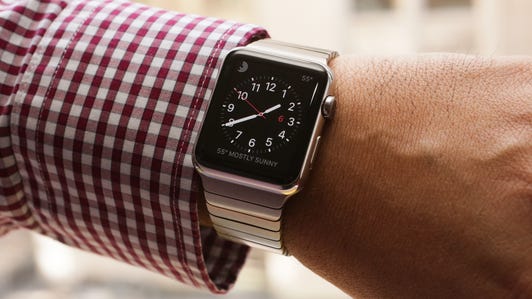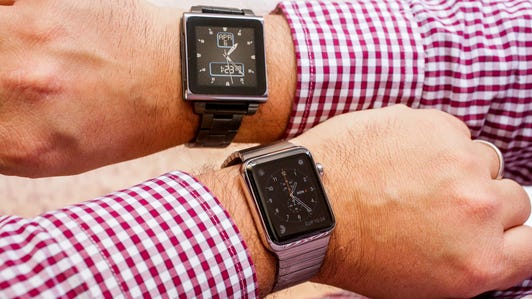
Shara Tibken/CNET
It wasn’t quite the biggest quarter in history, but Apple’s March period report still managed to impress.
The Cupertino, Calif., company on Monday posted record fiscal second-quarter revenue, iPhone and Mac sales. Apple also reported all-time record performance for its App Store and forecast strong sales for the current period. Fiscal second-quarter results didn’t measure up to the December period — the biggest quarter in Apple’s 38-year history and the largest profit of any public company ever — but they showed the continued strong demand for Apple’s gadgets.
Overall, the company continues to benefit from huge iPhone demand, particularly in emerging markets such as China. Consumers have been scooping up Apple’s larger-screen smartphones — the 4.7-inch iPhone 6 and 5.5-inch iPhone 6 Plus — at record rates since they hit the market in September. But they’ve also stopped buying as many iPads, Apple’s No. 2 moneymaker after its smartphones.
Here’s what Apple CEO Tim Cook had to say about the quarter:
Apple’s business is a one-legged stool — iPhone
Former Apple CEO Steve Jobs once described his company as a three-legged stool with the iPhone, iPad and Mac generating strong revenue. But for the past couple quarters, it has been all about the iPhone. About 70 percent of Apple’s revenue has come from its smartphone line since the beginning of this fiscal year. Traditionally, the level has been closer to 50 percent.
See also
- iPhone demand pushes Apple to record Q2
- Apple’s Cook sees Watch hitting more countries in late June
- Apple boosts capital return program to $200 billion
- China passes US to become Apple’s biggest iPhone market
The reliance on one device has caused some worries. If iPhone sales suddenly slow down, Apple’s results could drop. But market watchers believe the new iPhone 6 and 6 Plus could keep sales going for a while. And Cook noted during the call with analysts that Apple has seen more people switch to iPhone from other devices, such as Android, than it has experienced with other iPhone launches. He added that only about 20 percent of current iPhone users have upgraded to the larger-screen smartphones, which were released in September.
Overall for the second quarter ended March 28, Apple sold 61.2 million iPhones, up from 43.7 million in the year-earlier period but below the record 74.5 million sold in the first quarter. Analysts expected the company to sell 57.2 million iPhones in its second quarter, according to a poll by Fortune.
“If you look at the overall worldwide, we grew iPhone 40 percent. And IDC’s estimate of the market for last quarter is 16 percent. So we grew 2.5 times. And if you kind of look through at the different countries, in almost every country we grew at a multiple of the market. And as I’ve mentioned before, in emerging markets we did extremely well.
And so I feel really good about where we are and you can hopefully tell with the strong guidance that we provided that we’re very bullish on the current quarter as well. And so I think things look very, very good. We’re also pleased, in addition to the switcher number, that we’re doing fairly well with first-time buyers, which is also a key metric for us. And so it’s tough to find something in the numbers not to like. ….
Our current estimate is that about 20 percent of the active install base has upgraded to a 6 or 6 Plus. And so as I look at that number, that suggests there’s plenty of upgrade headroom in addition to we want to keep inviting over as many switchers as we can. So between both of those and the first time buyers as well, it seems really, really good right now.”
Cook is ‘really happy’ with Apple Watch. But it’s hard to get one
The Apple Watch, which comes in 38 variations and costs from $349 to $17,000, is a very different gadget for Apple, which has tended to offer a limited number of models in its product lines. The company also is selling the Apple Watch differently, limiting the device to online sales only for the foreseeable future. Preorders for the smartwatch started April 10, and it hit the market April 24.


Now playing:
Watch this:
We destroyed the Apple Watch
4:40
The Apple Watch rollout is a major test for Cook, who needs to show that the company can still create lust-worthy, must-have products in new categories. The last time it did that was in 2010 with the “magical” iPad tablet, which was ushered to market by Apple co-founder Steve Jobs before he died the following year.
Apple in October said it wouldn’t break out Apple Watch sales during its quarterly earnings reports, but many hoped the company would give some details about first-weekend sales during its second-quarter earnings call. Instead, Cook talked about Apple’s aim to make enough smartwatches to meet supply.
“It’s been really great to see the reaction of customers since their watches began arriving on Friday morning. All around the world we’ve seen the excitement on social networks as people start using their Apple Watch. The response has been overwhelmingly positive.
Adding to the surprise and delight of Apple Watch are the more than 3,500 apps that are already available. Our developer community has already seen the potential in this new category and puts some of their best thinking in to what wearable technology can do. We can’t wait to see more of the inspiring apps developers dream up for Apple Watch as we head into our Worldwide Developer Conference six weeks from now. …
Let me talk about supply and demand and sort of separate those two. Right now demand is greater than supply. And so we are working hard to remedy that.
We’ve made progress over the last week or so and we’re able to deliver more customers an Apple Watch over the weekend than we had initially anticipated. We’re going to keep doing that. And so we’ve already sent some notes out today with moving other customers in verses what we had communicated to them previously. So I’m generally happy that the — that we’re moving on with the ramp.
It is a new product for us. And with any kind of new product, you wind up taking some time to fully ramp [up production]. Having said that, I think we’re in a good position. And by some time in late June, we currently anticipate being in a position that we could begin to sell the Apple Watch in additional countries. And so that’s our current plan.
From a demand point of view, it’s hard to gauge when you’re — you don’t have product in stores and so forth. And so we’re filling orders completely online at the moment. The customer response from people that have gotten theirs over the weekend have been overwhelmingly positive. …
We are learning quickly about customer preferences between the different configurations. There’s a much larger breadth of possibilities here for customers than in our other products. And in some cases, we called that well and some cases we’re making adjustments to get in line with demand.
But I’m really confident that this is something we really understand how to do and will do. And so I’m really happy where we are currently and happy enough that we’re looking forward to expanding into more countries in late June.”
China is huge for Apple
As smartphones sales in developed markets slow, regions such as China become more important to handset vendors. China became the world’s largest smartphone market in 2011 and now is home to almost 520 million smartphone users. Apple has been working to gain market share in the country by reaching deals with major carriers in the region. An agreement with the world’s largest carrier, China Mobile, in January 2014 gave Apple access to more than 800 million subscribers.
Apple Watch: A hands-on tour of Apple’s first smartwatch (pictures)






Along with becoming the world’s biggest smartphone market overall, China is fast becoming the most important market for Apple. The region passed the US as the world’s biggest iPhone market in the second quarter and surpassed Europe to become the second-biggest revenue generator overall after the Americas.
Second-quarter revenue in the region, which got a boost from the Chinese New Year in February, soared to a record $16.8 billion from $9.84 billion a year ago. China was the only region detailed in Apple’s earnings report where March sales topped those of the first quarter, though they rose a scant 4 percent. Cook on China:
“It was an incredible quarter. We were up 71 percent year-over-year. We set a record in China for revenues. We did that now in a quarter that included Chinese New Year. And so we had the help of the strong holiday season, much like the US has a strong season in December, China’s is obviously in the March quarter.
iPhone led the way, was up over 70 percent year-on-year. And the current estimates from [research firm Kantar] are that that would mean that we would gain more that 9 points of share on a year-over-year basis. And so we — by everything I can see — we did extremely well.
The Mac also had an unbelievable quarter in China, and I’m particularly very happy with this. The Mac unit sales were up 31 percent. And like the rest of the world, or most of the rest of the world, IDC is projecting that PC sales in China contracted by 5 percent last quarter. And so, once again, bucking the tide.
Also in China, consistent with the company but at a much different rate, the App Store had a record quarter and grew over 100 percent year-over-year. And so you can see the iPhone, the Mac and the App Store adding [to results]. And with the iPad in the [People’s Republic of China], not in greater China but in the PRC, iPad had its best quarter ever, higher than all of the others and also grew in a market that contracted for the overall market. And so really and truly sort of everything you look at in China was extremely good. …
We worked significantly on our online store, and our online store revenue was up over three times year-over-year. As you probably heard us say before, we’ve opened several stores in China recently. We’re now at 21 in greater China and we’re on track, still, to achieve 40 stores by the middle of next year.
The online store will also be expanding from around 319 cities to where they can hit two-day delivery to 365 cities. So adding about 50 new cities by the end of this quarter.
And so the net is, we’re adding, we’re investing a lot across the board in our infrastructure, in our products, on partnering with different companies. The Chinese developers are coming on in significant numbers. We’ve now made payments to developers in greater China of almost $5 billion, over half of which was in the last 12 months. And so you can see this enormous momentum building in the developer community there as well.
And so lots of positive things. And as I’ve said — as you’ve probably heard me say before, I’ve never seen as many people coming into the middle class as they are in China. And that’s where the bulk of our sales are going. And so we’re really proud of the results there and continue to invest in the country.”
iPad is hurting but should turn around. Sometime
iPad sales posted their fifth consecutive decline to 12.6 million units, from 16.4 million a year earlier. Analysts expected Apple to sell 14.1 million iPads, according to an analyst poll by Fortune. Consumers have been holding on to their tablets for longer and opting to purchase bigger-screen iPhones instead.
Apple introduced its newest tablets — the iPad Air 2 and the iPad Mini 3 — in October, but analysts said their incremental changes, including faster processors, weren’t enough to attract buyers. The company, which has long claimed iPad weakness is a “speed bump,” is now counting on a partnership with IBM to increase iPad sales to business users. Still, the question top of mind for analysts and investors is just when iPad sales turn around. Cook didn’t have an answer:
“Have we had cannibalization? The answer is yes. We’re clearly seeing cannibalization from iPhone and on the other side from the Mac. And of course, as I’ve said before, we’ve never worried about that. It is what it is. That will play out and at some point it will stabilize. I’m not sure precisely when but I’m pretty confident that it will.
The IBM partnership I think is in its early stages in terms of bearing fruit here, but everything I see I like on it. I’m a big believer in the ability for iPad to play in a major way in enterprise. And so I’m looking forward to seeing that play out as we move forward.
When you look at the underlying data, it makes you feel a lot better than the sales do. And so things like first-time buyer rates, the latest numbers from the US are somewhere around 40 percent. And if you look at China, they’re almost 70 percent. And so these numbers are not numbers that you would get if the market were saturated. And so I continue to believe, even though I’ve seen different people write that, that I think that theory is not correct and do not see that.
We also see usage numbers that are off the charts, so far above competition, it’s not even in the same planet. And we see customer satisfaction at or near 100 percent. And so these kind of numbers, along with intent to buy numbers, everything looks fantastic. …
And so my belief is that as the inventory plays out, as we make some continued investments in our product pipeline, which we’re doing, that we already had planned and have had planned for some time. Between that, the inventory playing out, the enterprise starting to take over, I think, still, I believe the iPad is an extremely good business over the long term. When precisely it begins to grow again, I wouldn’t want to predict, but I strongly believe that it will.”



